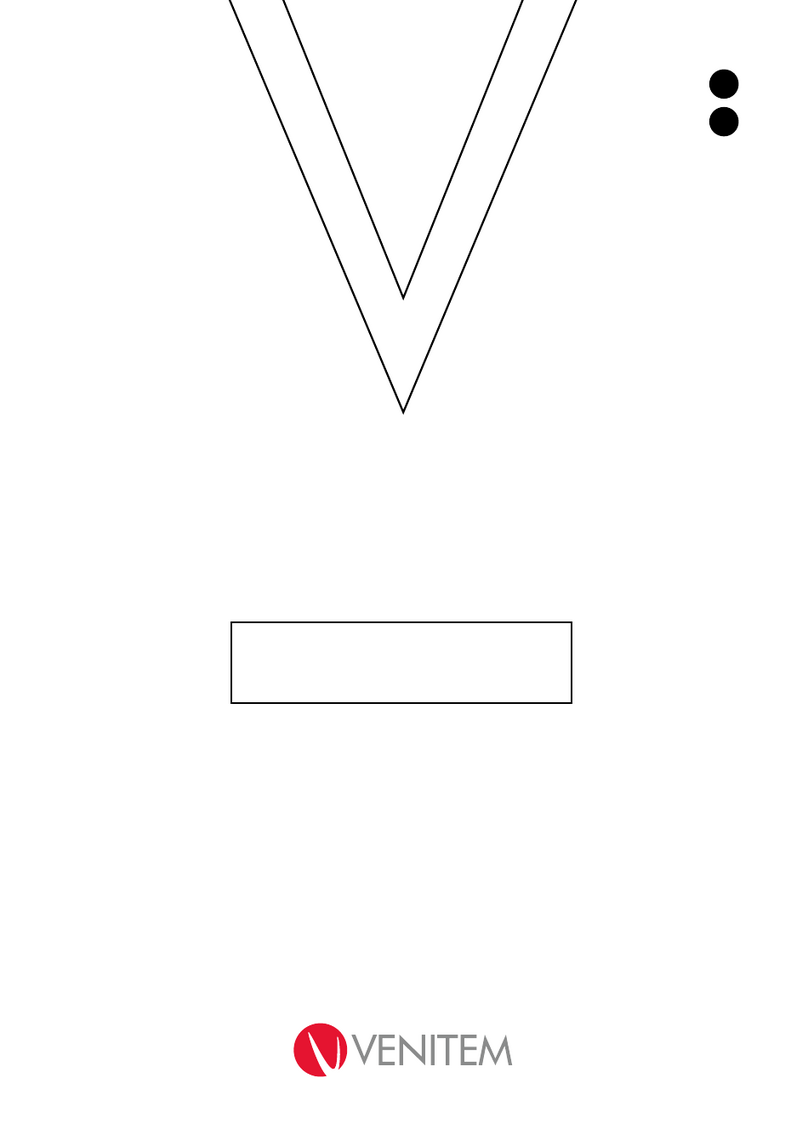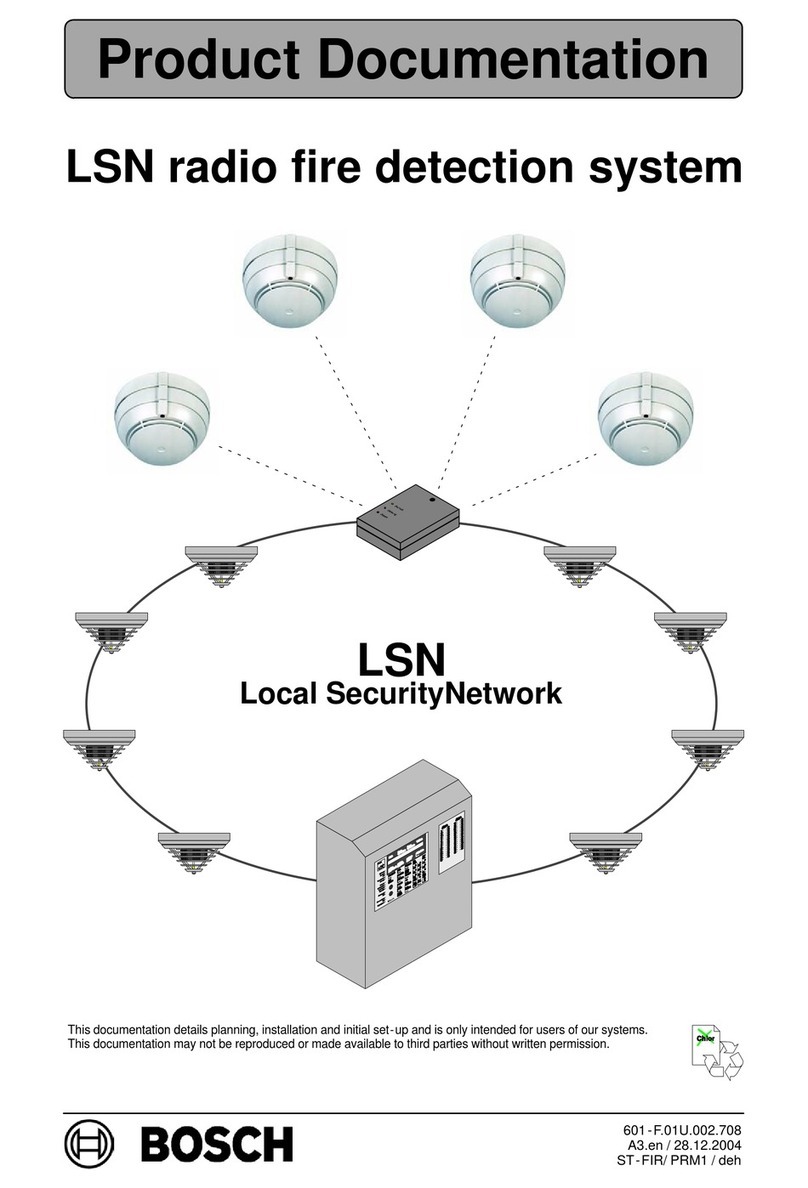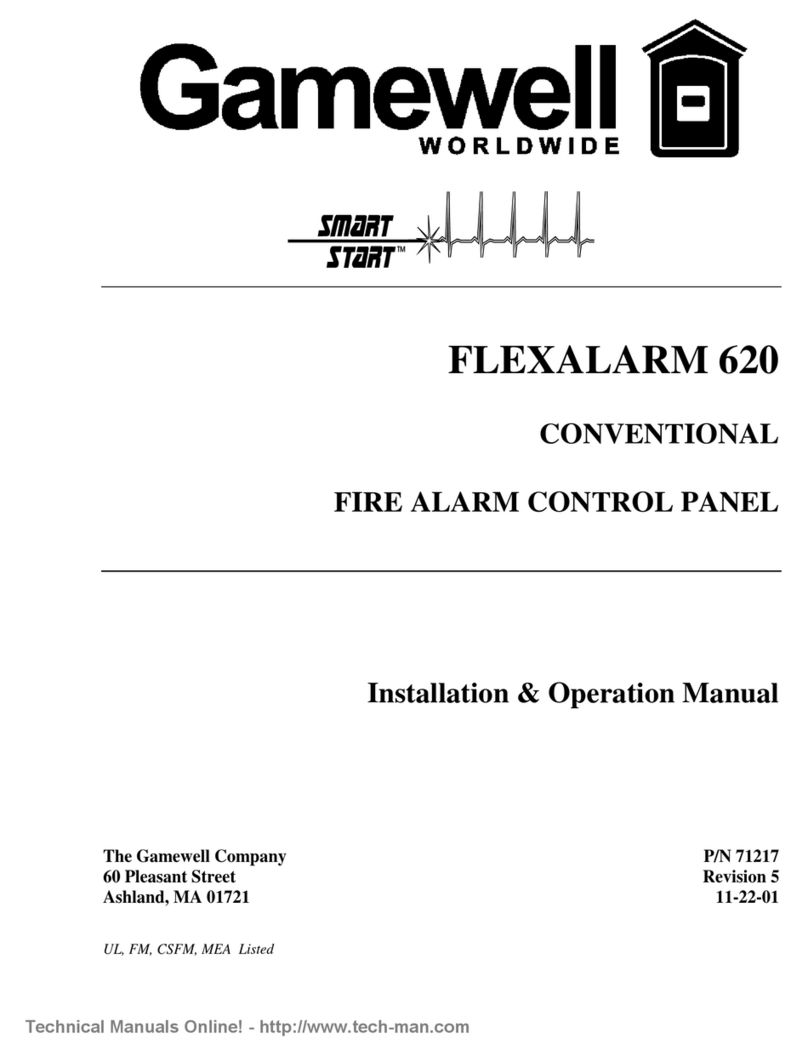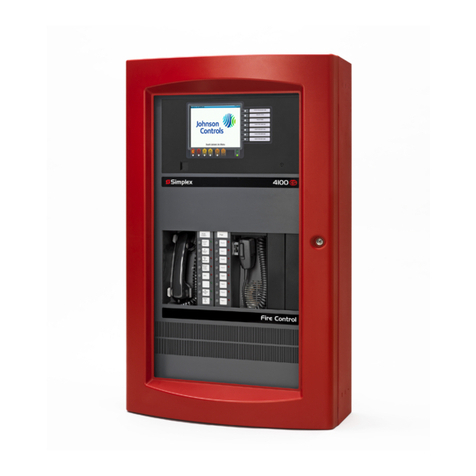C&S YA60BD User manual

Page - 1 -
A division of Signature Ind. Ltd
D7292 OPERATING AND INSTALLATION 2
Tom Cribb Road, Thamesmead
London SE28 0BH
Tel: +44(0)20 8316 4477
or (0)20 8317 1717
Fax: +44(0)20 8317 2400
www.cliffordandsnell.com
OPERATING AND INSTALLATION
INSTRUCTIONS FOR ATEX AND IECEX
YODALEX FLAMEPROOF AUDIBLE AND
V
ISUAL ALARMS
D7292/12

THESE INSTRUCTIONS MUST BE READ AND UNDERSTOOD BEFORE CARRYING OUT
ANY WORK ON THE ALARM.
Do not discard any packing material until installation is complete.
THESE ALARMS SHOULD ONLY BE INSTALLED BY COMPETENT PERSONNEL
These alarms are certified in accordance with the ATEX Directive 94/9/EC. The certificate
numbers and their associated marking are as follows:
Baseefa02ATEX0212X
CE1180 II 2 GD - Ex dIIB T 135°C (Tamb –35 °C to +60 °C)
II 2 GD - Ex dIIB T 85°C (Tamb –35 °C to +40 °C)
Baseefa02ATEX0222X
CE1180 II 2 GD - Ex dIIB+H2T 135°C (Tamb –20 °C to +60 °C)
II 2 GD - Ex d IIB+H2T 85°C (Tamb –20 °C to +40 °C)
These alarms are certified in accordance with the IEC60079-0:2004 Edition 4 and IEC60079-
1:2003 Edition 5. The certificate numbers and their associated marking are as follows:
IECEx BAS05.0086X
Ex d IIB T4 (Tamb –35 °C to +60 °C)
Ex d IIB T6 (Tamb –35 °C to +40 °C)
IECEx BAS05.0087X
Ex d IIB+H2T4 (Tamb –20 °C to +60 °C)
Ex d IIB+H2T6 (Tamb –20 °C to +40 °C)
No alteration to the unit is allowed. In case the unit becomes faulty, It must be returned to the factory.
‘This equipment is designed and manufactured to protect against other hazards as defined in
paragraph 1.2.7 of Annex II of the ATEX Directive 94/9/EC.’
D7292/12
Page - 2 -

Page - 3 - D7292/12
INSTALLATION AND OPERATING INSTRUCTIONS
These instructions apply to the following Alarm models:
Flameproof audible range, sounder type YO6 YA60BD, YA60BF, YA60BL, YA60BN
YA60CD, YA60CF, YA60CL, YA60CN
Flameproof visual range, strobe type V6 5J FL60BD50, FL60BF50, FL60BL50, FL60BN50
FL60CD50, FL60CF50, FL60CL50, FL60CN50
10J FL60BD100, FL60BF100, FL60BL100, FL60BN100
FL60CD100, FL60CF100, FL60CL100, FL60CN100
20J FL60BD200, FL60BF200, FL60BL200, FL60BN200
FL60CD200, FL60CF200, FL60CL200, FL60CN200
Combined audible & visual range, type YL6 YL60BD50, YL60BF50, YL60BL50, YL60BN50
YL60CD50, YL60CF50, YL60CL50, YL60CN50
These products are a range of audible and visual alarms approved for use in potentially explosive
atmospheres, and have been ATEX and IECEx certified by Baseefa Ltd using EN60079-0 and EN60079-
1:2004 standards.
Models are available for use in hazardous areas with the following classifications: Group IIB and IIB+H2.
An alarm approved for use in a particular gas group may be used in areas where the gas group is of a lower
hazard. i.e. IIB+H2equipment is suitable for Gas groups IIB and IIA, also
IIB equipment is suitable for Gas group IIA also.
The alarms are suitable for outdoor use.
ALL INSTALLERS MUST PROVIDE SUPPLY LINE FUSES
The Yodalex alarms meet the requirements of standards BS EN60529:1992, Degree of protection IP66
General
The alarms must be installed in accordance with these instructions.
The alarms must also be installed in accordance with local codes and/or special requirements of any
authority having jurisdiction.
Models for connection to DC supplies have a DC lines status monitoring facility.

Page - 4 - D7292/12
PREPARATION
ENSURE THE SUPPLY IS OFF BEFORE COMMENCING INSTALLATION.
A. Check that you have the correct alarm to satisfy the system specification.
Gas group and temperature?
Audible or Visual alarm or both?
Supply voltage?
Sound signal selected ?
Strobe lens colour correct ?
Suitable mounting location ?
Cable connection and installation method ?
B. Location
•Select a suitable location for the alarm with regard to the area to be covered by the
sound or flash signal.
•The surface should be flat in the area of the fixings and the material suitable to carry the weight of the
alarm.
•For a sounder, the sound signal pattern is omni-directional and the sounder should be mounted with
the Horn at the top.
•For a strobe, the alarm should be mounted with the lens at the bottom and out of direct sunlight.
•In exceptional circumstances, the alarms can be mounted horizontally or for the strobe, with the lens
uppermost.
Do not mount the sounder with the Horn downwards.
•The cable must be connected to the alarm via a sealed component and this must be located adjacent
to the cable entries in the alarm body.
•Suitable sealing devices are a sealed threaded nipple or a sealed gland; the choice of device depends
upon the gas group applicable to the installation and on the chosen installation method.
•There are two entries to the alarm body and one or both may be used depending upon the number of
cable cores required by the system arrangement.
•It is preferable that the cable and its seal be fitted at the factory or approved workshop; however the
method for assembling the cable and sealed components is described below.
IMPORTANT
THE ALARM IS A PRECISION INSTRUMENT. TAKE EXTREME CARE WHEN HANDLING.
•Particular care is needed when removing or replacing components which form part of the flameproof
enclosure.
•Exposed joint surfaces must be protected and not have contact with dust or dirt, or be knocked against
any object.
•The end flanges must be fitted squarely and on no account is force to be used. The flange must not
be hammered, levered with a metal instrument or the fixing screws used to pull down the flange.
•With care and patience, it will be found that the flange enters the body without difficulty.
I. Combined Sounder/Strobe
It is recommended that the unit be stood upright in a cup-shaped base holding the strobe section.
Remove the Horn from the sounder flange by unscrewing the three self-tapping screws (pozi drive head) in
the dome of the Horn.
Unscrew the four socket headed screws, two washers and 'O' ring in the flange. (Socket head wrench 4mm
(5/32") across flats). These screws will not be fully tightened if the alarm is not a factory-sealed unit.
IMPORTANT: TAKE EXTREME CARE WHEN REMOVING THE SOUNDER FLANGE FROM THE MAIN
BODY.
DO NOT USE THE TRUMPET AS A LEVER.
•Unplug the pressure unit cable from the PCB assembly.
•The exposed joints must be kept clean of dirt and not damaged in handling.
•Lay down the sounder flange assembly to one side on a clean piece of the packing material.

Page - 5 - D7292/12
CABLE CONNECTION (ATEX ONLY)
•Cable entry hole(s) to accommodate any suitable ATEX certified flameproof cable entry device for gas
group IIB or IIC with or without the interposition of a suitable ATEX certified flameproof thread adaptor
and for which the cable is appropriate and suitable for the conditions of use.
Cable entry temperature may reach 70°C.
Cable entry devices must be ATEX certified suitable for either IIB for IIB gas group or IIC for IIB+H2
gas group. Any unused entry hole is to be closed using a suitable ATEX certified flameproof stopping
plug for gas group IIB or IIC with or without the interposition of a suitable certified flameproof adaptor
for gas group IIC (one Baseefa ATEX certified stopping plug is fitted by manufacturer as standard).
Suitable ATEX flameproof cable entry devices, thread adaptors and stopping plugs certified as
Equipment (not a Component) under an EC-Type Examination Certificate to Directive 94/9/EC may
also be used in the manner indicated above.
The terminals accept wires of 2.5 mm².
The PCB assembly may be lifted in its slide channels to give easier access to the terminals.
CABLE CONNECTION (IECEx)
•Cable entry hole(s) to accommodate any suitable certified flameproof cable entry device for gas group
IIB or IIC with or without the interposition of a suitable certified flameproof thread adaptor and for
which the cable is appropriate and suitable for the conditions of use.
Cable entry temperature may reach 70°C.
Cable entry devices must be certified suitable for either IIB for IIB gas group or IIC for IIB+H2gas
group. Any unused entry hole is to be closed using a suitable certified flameproof stopping plug for gas
group IIB or IIC with or without the interposition of a suitable certified flameproof adaptor for gas group
IIC (one certified stopping plug is fitted by manufacturer as standard).
The terminals accept wires of 2.5 mm².
The PCB assembly may be lifted in its slide channels to give easier access to the terminals.
SOUND SIGNAL SELECTION
•It is preferable if the sound signal selection is set at the factory or at an approved workshop.
•To make the sound signal selection, refer to the table of sound signals and the switch positions for the
chosen sounds (Page 8).
•Double check you have selected the correct switch positions for your chosen stage 1 alarm signal and
for your chosen stage 2 alarm signal.
•Check again before re-assembly of the alarm.
RE-ASSEMBLY OF THE ALARM
•Reconnect the pressure unit cable connection; make sure this is secure.
•Make sure the PCB assembly is correctly located in the slides in the body. Check that the flash tube
is clearly visible and centrally located in the glass dome.
•Re-assemble the sounder flange to the main body but take care that the pressure unit wire is not
trapped in the joint, across the edge of the PCB assembly or between the head of the earth screw and
the pressure unit.
•Check that the 'O' ring is properly fitted in the groove in the body.
•Take care when fitting the flange. This must be inserted squarely into the main body. Force must not
be used, with patience it will be found that the flange enters without difficulty.
•The screws must not be used to pull down the flange to the body.
•Each socket screw should be fitted with a lock washer, flat washer and an 'O' ring. The 'O' ring must
locate in the groove at the base of the counter bore. Screw down the socket screws tightly.
Note:
•If the alarm has been in service and/or the socket headed screws in the flange have been previously
tightened, it is advisable to replace the o-rings (Part No. GR0192) before retightening the screws.
•Refit the Horn to the Trumpet using the three self-tapping screws.
II. Sounder only
•The alarm may be stood on a clean surface on the flat base.
•The procedure should be followed as described for the Sounder/Strobe alarm above.

Page - 6 - D7292/12
III. Strobe only
•The alarm should be stood upright in a cup-shaped base, which holds the strobe lens steady.
•Remove the fixing screws, washers and o-rings in the base plate.
•Connect the cable via the entries in the enclosure to the PCB assembly using the method described
for the sounder/strobe alarm.
•Ensure that the 'O' ring is properly fitted in the groove of the body.
•Refit the base plate carefully, ensure the flange is squarely located in the enclosure and there is a
minimum gap between flange and body.
•Ensure each socket screw is fitted with a lock washer, flat washer and 'O' ring.
•Screw down socket screws tightly.
Lens Colour Change
•If it is required to change the lens colour of the strobe, it is necessary to purchase the required colour’s
strobe flange assembly from your supplier.
INSTALLATION
•Ensure that the mounting surface at the installed location is flat and suitable for carrying the weight of
the alarm.
•Remove the bracket, fixing screws and washers from the bag in the carton. Assemble the bracket to
the alarm body enclosure using two off hexagon head set screws(M6 X 16mm long), lock washers
and flat washers.
•Check that the bracket is tightly secured to the alarm enclosure. The fixings for the alarm to the
mounting surface are two holes (8.5mm (0.33in) on 75mm. (2.95in) centres.
•Suitable bolts (not supplied) for securing should be used.
INTERCONNECTION OF ALARMS
Alarms may be connected in parallel, that is, up to ten alarms with common supplies may be connected as a
single system loop. Both sets of terminals should be used to provide an 'in' and 'out' connection.
SYSTEM OPTIONS
Operating supply voltage 24Vdc, 48Vdc, 115Vac or 230Vac
Sound signal selections 32 (see table)
Alarm stages Single or Two from all sounders
Strobe Separate LIVE terminals for independent supply
Note: NEUTRAL is common
Live terminals labelled L1 and L2 should be linked
together with a suitable wire link on the mains PCB
Lens colours Clear; opal; red; amber; blue; green; yellow
Cable cores The number fitted depends upon the system requirements
EARTHING
•The alarm must be connected to a good quality earth.
•EARTHING points are provided both inside and outside the alarm enclosure. These EARTHING
points are identified with the Ground Symbol.
•The internal earth connection must be used. The external terminal is for a supplementary bonding
connection and is used where local code or authorities permit or require such connection.

Page - 7 - D7292/12
MISCELLANEOUS DATA
Combined Sounder Strobe
•Weight (kg). {dc} 5.0 4.4 4.1
{ac} 5.6 4.7 4.4
•All metal castings are of LM6 aluminium alloy, corrosion resistant, anodised and outside surfaces
finished with a polyester paint coating.
•The strobe dome is of clear borosilicate glass.
•The sound-shaping components are of flame retardant ABS.
•The coloured lens is of flame retardant polycarbonate.
•All external fasteners are of stainless steel.
•All sounders have 32 sound signal selections. From the 32 sound signals, any signal may be chosen
as the first stage alarm and any signal for the second stage alarm.
•Sound output level and current consumption depends upon the signal selected. Typical sound output
level at 1 metre is 110dB(A) and typical current consumption is 350 mA for 24VDC, 110 mA for 115
VAC and 55 mA for 230 VAC depending upon sound signal selected. These values apply for Gas
Group IIB; for Gas Group IIB+H2, sound output is reduced by typically 3dB.
•All strobes have a xenon flash rate of 1Hz, one flash per second. The flash energy is 5 joules with a
typical current consumption of 220 mA for 24VDC, 135mA for 48VDC, 90 mA for 115 VAC and 45 mA
for 230 VAC.
24VDC 48VDC 115VAC 230VAC
5 JOULES 220mA 130mA 90mA 45mA
10 JOULES 500Ma 300mA 105mA 53mA
20 JOULES 1.1A 500mA 260mA 170mA
WARNING: POSSIBLE ELECTROSTATIC RISK
The Horn and Lens may become electro-statically charged and should not be touched or rubbed when in
operational service. If cleaning is required follow the warning given on the equipment label and clean only
with a suitable damp cloth.
THREADED CABLE ENTRIES
All threaded cable entries to be fitted with an ATEX certified component and the thread sealed with a suitable
non-setting thread sealant to maintain IP66 rating.
SPECIAL CONDITIONS FOR SAFE USE (BASEEFA CERTIFIED)
•The equipment incorporates flameproof joints which have a maximum gap less than that
stated in the standard EN50018:2000 to which it is certified.
(Note: EN60079-1 replaces EN50018)
The user must ensure that the diametric clearance associated with the spigot joint at
each end cover does not exceed 0.064mm and the gap between the face of each end
cover and the body does not exceeed 0.038mm.
•For replacement purposes the end cover fixing screws shall be of minimum grade A4-80
stainless steel.
•The cable entry device shall be suitably sealed to maintain IP66 rating.

Page - 8 - D7292/12
SOUND SIGNALS
sound Freq. rept. sound switches
Signal rate 1 2 3 4 5
SW1,SW2special applications
1 Alternate two-tone 800-1000 0.5 1 1 1 1 1 Fire Alarms
2 Alternate two-tone 2500-3100 0.5 0 1 1 1 1 Security Alarms
3 Alternate fast two-tone 800-1000 0.25 1 0 1 1 1 Increased Urgency
4 Alternate fast two-tone 2500-3100 0.25 0 0 1 1 1 Security Deterrent
5 Alternate two-tone 440-554 0.4/0.1 1 1 0 1 1 Evacuation Alarm, FRANCE
6 Alternate two-tone 430-470 1.0 0 1 0 1 1
7 Alternate v.fast two-tone 800-1000 0.13 1 0 0 1 1
8 Alternate v.fast two-tone 2500-3200 0.07 0 0 0 1 1
9 Alternate two-tone 440-554 2.0 1 1 1 0 1 Turn-out, SWEDEN
10 Continuous note 700 - 0 1 1 0 1 All Clear, SWEDEN
11 Continuous note 1000 - 1 0 1 0 1
12 Continuous note 1000 - 0 0 1 0 1
13 Continuous note 2300 - 1 1 0 0 1
14 Continuous note 440 - 0 1 0 0 1
15 Interrupted tone 1000 2.0 1 0 0 0 1
16 Interrupted tone 420 1.25 0 0 0 0 1
17 Interrupted tone 1000 0.5 1 1 1 1 0
18 Interrupted tone 2500 0.25 0 1 1 1 0
19 Interrupted tone 2500 0.5 1 0 1 1 0
20 Interrupted tone 700 6/12 0 0 1 1 0 Pre-vital Message, SWEDEN
21 Interrupted tone 1000 1.0 1 1 0 1 0
22 Interrupted tone 700 4.0 0 1 0 1 0 Air-raid Alarm, SWEDEN
23 Interrupted tone 700 0.25 1 0 0 1 0 Local Warning, SWEDEN
24 Interrupted tone 720 0.7/0.3 0 0 0 1 0 Industrial Alarm, GERMANY
25 Int,fast,rising volume 1400 0.25 1 1 1 0 0
26 Fast siren 250-1200 0.085 0 1 1 0 0
27 Rising constant,fall 1000 10/40/10 1 0 1 0 0 Industrial Alarm, GERMANY
28 ISO 8201 Evacuation 800-1000 as std 0 0 1 0 0 International Evacuation Alarm
29 Fast whoop 500-1000 0.15 1 1 0 0 0
30 Slow whoop 500-1200 4.5 0 1 0 0 0 Evacuation Alarm, Netherlands
31 Reverse sweep 1200-500 1 1 0 0 0 0 Evacuation Alarm, GERMANY
32 Siren 500-1200 3.0 0 0 0 0 0
switch settings: ON=1 and OFF=0
The PFEER sound signals recommended by UKOOA are:-
General Alarm Sound Signal 15 Interrupted tone 1000 Hz
PAPA Sound Signal 31 Reverse Sweep 1200-500 Hz
Toxic Gas Sound Signal 11 Continuous Tone 1000 Hz.

AC ALARM CONNECTION AND SOUND SIGNAL SELECTION
D7292/12
Page - 9 -

ALARM CONNECTION FOR TELEPHONE INITIATE
Connection is as per the diagram above. The supply is on all the time with the
Sounder and/or Flasher only working when a ring tone is detected on the telephone
input.
Note:- The Sounder will follow the ring tone whilst the the Flasher will remain flashing
only switching Off 4 seconds after the Telephone has been answered.
Not suitable for UL applications.
D7292/12
Page - 10 -

AC ALARM CONNECTION FOR 10/20J BEACONS
DC ALARM CONNECTION FOR 10/20J BEACONS
D7292/12
Page - 11 -

DC ALARM CONNECTION AND SOUND SIGNAL SELECTION
A. Two stage alarm by third core
Strobe shown with common 0v, with sounder
Line monitoring by supply reversal
Select alarm stage 1 on SW1
Select alarm stage 2 on SW2
NOTE: That the two stage control always operates as follows:-
The first stage sounds by supplying volts to a unit via control switch ‘x’,
This switch remains on and the second stage signal is controlled by
switching volts to the third terminal via switch ‘y’.
Earth
Connection
To Next Sounder
432
TB313
4TB22
Sound Selection
Pressure Unit Connector
x
y
TB1
to next strobe
14321
0v
Sounder
& Strobe Sounder
+24v dc Earth
Strobe
+24v dc
LK2 removed (link 24v dc)
LK1 (link 0v)
(On other side of PCB)
(On other side of PCB)
Earth
Connection
432
TB313
4TB22
Sound Selection
Pressure Unit Connector
x
TB1
14321
Strobe
0v Sounder
+24v dc Earth
LK2 (link 24v dc)
LK1 (link 0v)
(On other side of PCB)
(On other side ofPCB)
resistor (E.O.L)
Earth
Connection
432
TB313
4TB22
Sound Selection
Pressure Unit Connector
x
TB1
14321
Earth
LK2 removed
(link +24v dc)
LK1 removed
(link 0v)
(On other side of PCB)
(On other side of PCB)
resistor (E.O.L)
Strobe
0v +24vdc Sounder
0v +24vdc
resistor (E.O.L)
Line monitoring by supply reversal
Single Stage Alarm, Sounder and Strobe
operate separately
Line monitoring by supply reversal
Single Stage Alarm, Sounder and Strobe
operate together
D7292/12
Page - 12 -

DC ALARM CONNECTION AND SOUND SIGNAL SELECTION
B. Two stage alarm by Supply reversal
Line monitoring by threshold method (<1V)
Select alarm stage 1 on SW1
Select alarm stage 2 on SW2
Strobe operated from separate supply.
C. Two stage alarm by third core
Strobe flashes for both 1st and 2nd stages of
sound alarm.
Line monitoring by supply reversal
Select alarm stage 1 on SW1
Select alarm stage 2 on SW2
Common su
pp
l
y
to Sounder and Strobe
NOTE: That the two stage control always operates as follows:-
The first stage sounds by supplying volts to a unit via control
switch ‘x’, This switch remains on and the second stage signal is
controlled by switching volts to the third terminal via switch ‘y’.
(OnothersideofPCB)
SoundSelection
(OnothersideofPCB)
PressureUnitConnectorEarth
Connection
4TB3
3214TB2
321432
TB11
Earth
LK2(link24vdc)
LK1(link0v)
ToNextSounder
& Strobe
x
y
Sounder& Strobe
0v+24vdc
tonextstrobe
LK1removed(link0v)
0v+24vdc
(stage1)
+24vdc0v
(stage2)
Strobe
0v+24vdc
(OnothersideofPCB)
(OnothersideofPCB)
SoundSelection
PressureUnitConnectorEarth
Connection
4
ToNextSounder
2
3TB313
42
TB2
LK2removed(link24vdc)
TB1
13
41
2
Earth
D7292/12
Page - 13 -

DC ALARM CONNECTION AND SOUND SIGNAL SELECTION
NOTE: That the two stage control always operates as follows:-
The first stage sounds by supplying volts to a unit via control
switch ‘x’, This switch remains on and the second stage signal is
controlled by switching volts to the third terminal via switch ‘y’.
E. Single stage alarm
Line monitoring by supply reversal
Select alarm stage 1 on SW1
Strobe shown with common 0v, with Sounder
D. Two stage alarm by Third core
Strobe flashes for 2nd stage of sound alarm, link TB2/3 to TB1/2
Line monitoring by supply reversal
Select alarm stage 1 on SW1
Select alarm stage 2 on SW2
Common su
pp
l
y
to Sounder and Strobe.
(OnothersideofPCB)
SoundSelection
(OnothersideofPCB)
PressureUnitConnectorEarth
Connection
4TB3
3214TB2
32
LK2removed(link24vdc)
1432
TB11
Earth
LK1(link0v)
ToNextSounder
x
tonextstrobe
0v
Sounder
&StrobeSounder
+24vdc
Strobe
+24vdc
(OnothersideofPCB)
SoundSelection
(OnothersideofPCB)
PressureUnitConnectorEarth
Connection
4TB3
3214TB2
32
LK2removed(link24vdc)
1432
TB11
Earth
LK1(link0v)
ToNextSounder
& Strobe
x
y
0v+24vdc
D7292/12
Page - 14 -
This manual suits for next models
39
Table of contents
Popular Fire Alarm manuals by other brands

Siemens
Siemens Cerberus CS1140 Commissioning Extinguishing
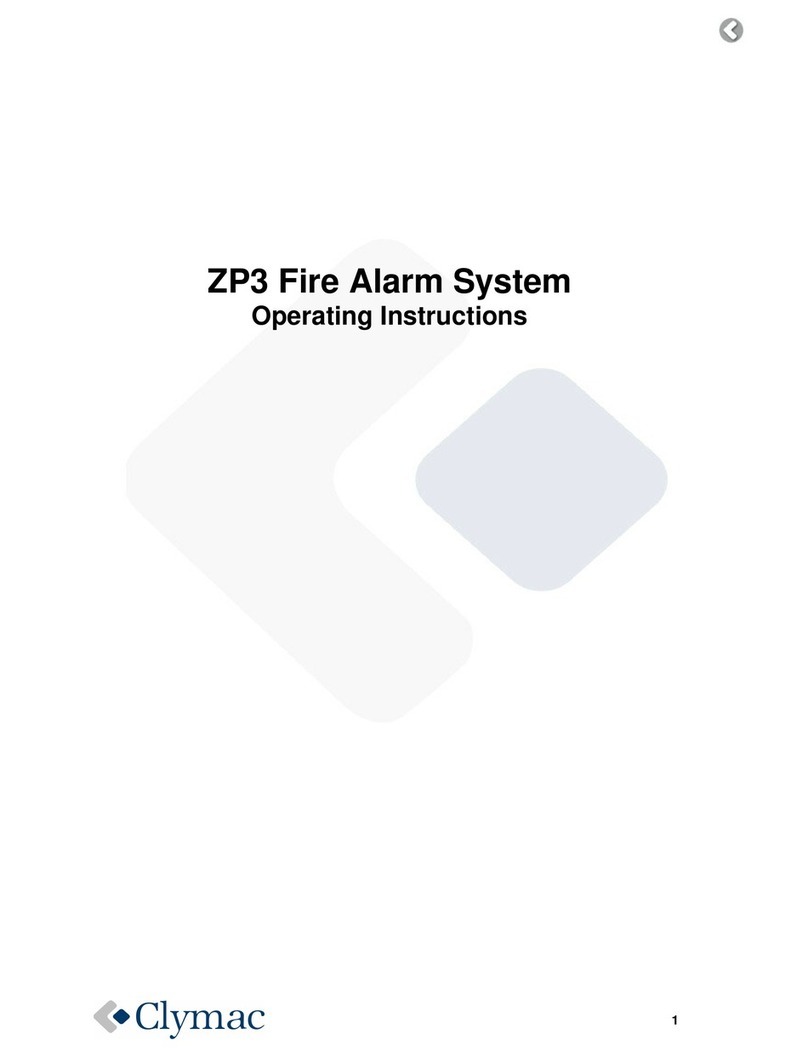
Clymac
Clymac ZP3 operating instructions

Honeywell
Honeywell Fire-Lite Alarms BG-12S manual
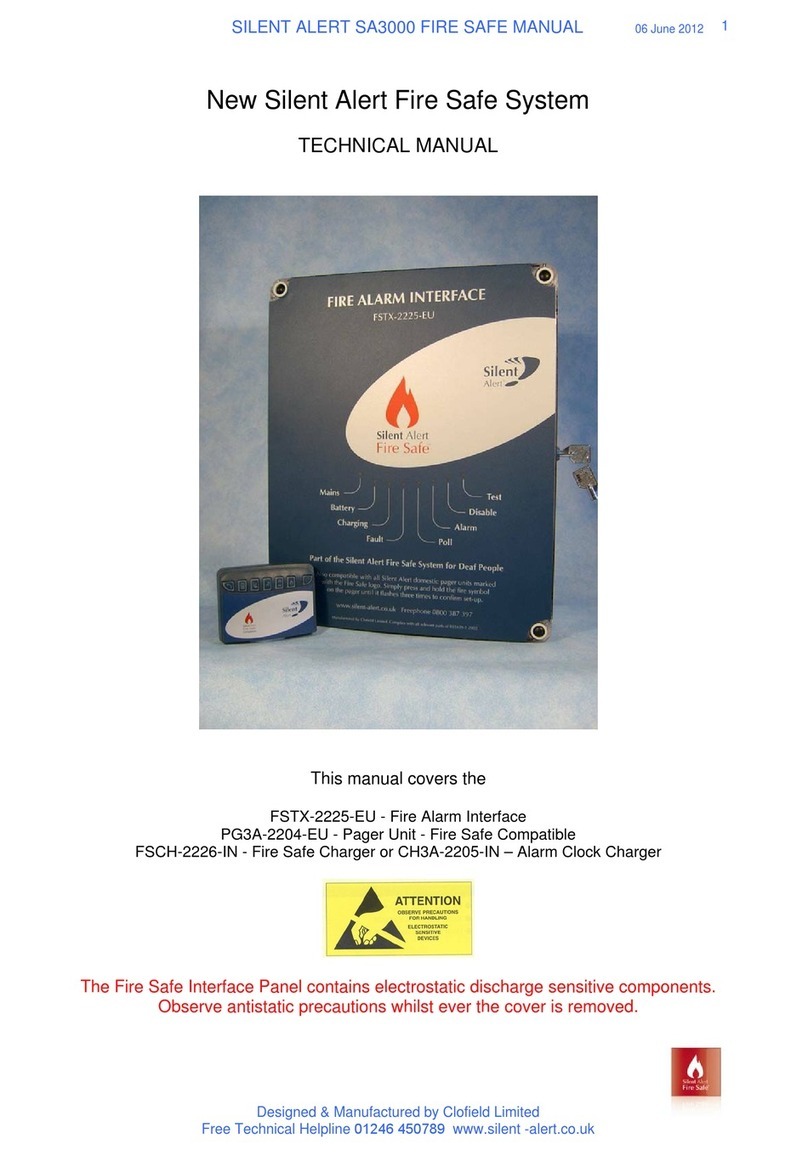
Silent Alert
Silent Alert SA3000 Technical manual

Task Force Tips
Task Force Tips CROSSFIRE Instructions for installation, operation, maintenance

usi
usi MIC1509S Quick reference guide


